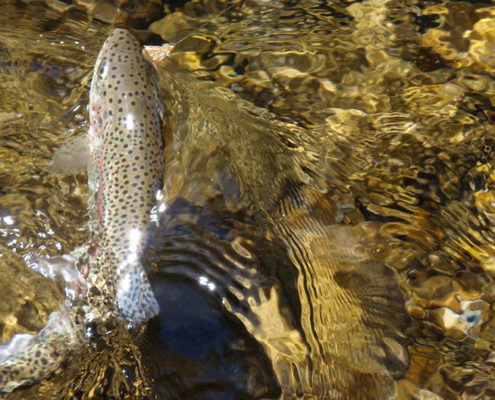Jubilee Lake, Oregon Trout Fishing
Arrival of the summer solstice is my signal to transition from sage‐lined seep lakes and associated swamp water trout to where Bigfoot resides in the Blue Mountains of northeastern Oregon. You might eat the dust of a travel trailer to get there, but you won’t have to pick ticks off your pant leg at the end of the day.
Jubilee Lake is the main game in town if you want to fish slack water in the Tollgate region of the Blues. This 20‐acre jewel of a lake, created in the late 1960s by damming tiny Mottet Creek, is located 12 miles northeast of Tollgate. Forest Service Road #64, off Highway 204 to Elgin, leads you there. Adjacent to Jubilee is the largest (50 camp sites) and most popular fee‐based campground in the Umatilla National Forest. A walk‐in road allows public access to the north end of the lake.
 Because Jubilee is a mile‐high lake that freezes over each winter, it’s primarily a put‐and‐take fishery for catchable‐sized rainbow trout; however, holdovers up to 16 inches are possible following a mild winter. In 2011, the first stocking occurred in early June followed by additional plants over the next 2 months for a total of 16,000 legal‐sized and 300 trophy trout. These trout grow quickly and are aggressive feeders in the cool mountain air.
Because Jubilee is a mile‐high lake that freezes over each winter, it’s primarily a put‐and‐take fishery for catchable‐sized rainbow trout; however, holdovers up to 16 inches are possible following a mild winter. In 2011, the first stocking occurred in early June followed by additional plants over the next 2 months for a total of 16,000 legal‐sized and 300 trophy trout. These trout grow quickly and are aggressive feeders in the cool mountain air.
Start your morning by exiting the campground to wade along the east shoreline keeping the sun at your back. The shoreline drops off steeply here and, with little room for a back‐cast, the odds are good that you will leave hook and hackle on tall white fir that line this part of the lake. Spend a quiet moment observing trout rising behavior before deciding to go with a nymph or a dry fly. Target shoreline points and underwater stumps with a gold bead pheasant tail, prince nymph, renegade or blue dun, sizes 10 to 16. In the middle of the day, when trout become wary, work drop‐offs opposite the main camping area. Switch to a dark caddis or parachute Adams when trout move in close for the evening rise. Schedule dinner to spend the last hour of daylight fishing. I generally wade the north shore in a clockwise direction because of prevailing southwest winds. On calm days, much of the lake can be worked from a float tube.
As water temperatures warm in late summer, trout seek out the main overflow channel near the earthen‐berm outlet dam. Paddle a slow troll there with a wooly bugger on long leader off sink tip line. Strikes increase in frequency once you get your offering below the shallow thermocline. Try the narrow inlet arm where Mottet Creek feeds cool water while on the lookout for a mid‐summer damselfly hatch. When this happens, bruiser trout cruise the edge of bulrush looking for something to eat other than a scrawny mayfly. Jubilee’s season stretches into September, but crowds thin out after Labor Day to provide the appearance of a private lake. No matter when and where you choose to fish, it is a pleasant scene with rarely more than half a dozen anglers working the shoreline.
Only non‐motorized watercraft, including float tubes, pontoon boats and cartoppers, are allowed at Jubilee. There is handicap access near the day‐use area and a graded perimeter trail circles the entire lake. Books close October 31 on the five fish per day, 8‐inch minimum size limit.
Side‐trips are possible from the Jubilee area that allow you to drop down to remote areas of the South Fork of the Walla Walla River via Burnt Cabin and Mottet Meadow trails (off FS #6401 and #6403, respectively), and to Looking Glass Creek off FS #6306. Both rivers provide spectacular action for native rainbow and bull trout. By all means, visit the Blues in August if you favor fresh huckleberries on your pancakes.
Dennis Dauble is the author of the award-winning “Fishes of the Columbia Basin” and “The Barbless Hook”.
